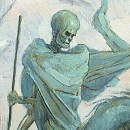5 Horrifying Apocalyptic Scenarios (That Have Already Happened)

It's impossible to turn on the news or go the movies without hearing about some disease or cataclysm that's about to end the world. There's a movie coming (2012) that as far as we can tell is about every apocalypse happening at once, and in the news the flavor of the week is swine flu--though so far the fatality rate has fallen rather short of, say, Popsicles.
Our apocalypse fixation ignores the fact that the things we're afraid of are old-hat. Extinction level events have happened again and again throughout history and, lo and behold, we're still here. And hell, we probably wouldn't be without number five...
The K-T Extinction

Everyone knows this story: For millions of years, dinosaurs roamed the earth, snacking on the odd mammal that was unfortunate enough to get in their way. They were big, hungry and had some terrifying weaponry.

As for mammals, our only saving grace was that we bred like crazy and were too small to easily kill. We presumably spent our days scurrying in terror and it was pretty clear who'd won the genetic lottery.
Then one sunny day 65 million years ago, a big rock fell out of the sky like a game of cosmic billiards gone drunkenly sour. This falling space matter is suspected to have made the 110-mile-wide Chicxulub crater in the Yucatan.
To understand the scale of the collision, know that according to newer versions of the theory, the crater in question was caused by only one of several fragments of a larger asteroid that did to our planet what a falling cinder block does to a Chihuahua. Also remember that the Yucatan crater is 100-damn-miles across.

The initial blast(s) threw up enough ash to blot out the sun, killing all plant life. With the plants gone, the food chain snapped, leaving all the dinos yabba-dabba dead. The mammals' policy of being small and annoying paid off, and they grew up to be us, you and the Knicks City Dancers.

"Suck it, T-Rex!"
The K-T rock was six-miles across. If that sounds big, know that the earth is approximately 7,000-miles across (which is quite small by stellar standards). Heck, K-T wasn't even the biggest one to hit our planet--a few billion years ago, one such impact shat out the entire moon.

Documentary.
Don't worry, though. The good news is that we have dedicated teams of nerds giving up their social lives to stare at the night sky in order to tag and track most cosmic debris in the solar system longer than a mile.
The bad news is that objects smaller than mile across can still ruin your day, particularly if your name is Ann Hodges.
The Clovis Comet

So could something like K-T happen to humans? Well, it already did. In Michigan. Crap.

They call it the Clovis Comet, and if you want a very small idea of the scale of this thing, look at the above photo.
At first glance, you may believe that this image is the result of nuclear testing, rabid beavers or some horrifying combination thereof. In fact, this is a picture of the aftermath of the Tunguska explosion, which demolished Siberia in 1908. The blast, which some scientists attribute to an earthbound comet, leveled 80 million trees with the force of 1,000 Hiroshimas.
Scary, right? Now raise Tunguska to the power of "holy fuck" and you'll get an inkling of how devastating the Clovis Comet was. "How devastating?" you query. Well experts say it was an explosion equal to about 1.5 billion Hiroshima bombs (or 20 million Megatons).

The Clovis Comet exploded over the Great Lakes about 12,900 years ago. The blast ignited continent-wide forest fires, spurred global cooling and killed all the neat animals like mastodons and 14-foot tall grizzly bears.

We're actually glad he's extinct.
As humanity's big innovation that millennia was putting the meat on sticks before cooking it, we weren't in much of a position to do anything about the biosphere turning into tears and excrement, so we apparently gritted our teeth and boned our way back to the top.
The Bubonic Plague(s)

The bacterium, Yersinia pestis, has beaten the human race into a gibbering mess with such regularity that it's embarrassing. The first known outbreak--the Plague of Justinian--hit the Byzantine Empire in 541 AD. At its peak, the contagion killed an estimated 5,000 people a day in Constantinople.

Just look at these smug bastards.
Think of it this way--if you met a friend for a nice cup of Turkish coffee, chances were one of you was either A) infected or B) already dead. And if your buddy looked healthy, it was probably a good time to go update your will.

"Sigh. Stood up again."
After killing 50-60 percent of Europe's population, the Justinian Plague laid low for a couple centuries, repackaged itself as the Black Death and killed a third of Europe from 1348-1350. Like your mom's cooking, the bubonic plague wouldn't stay down--it hung around until the 1600s, when improved medicine and sanitation stanched its spread. And like your mom's cooking, the Black Death gave people fatal, necrotic tumors.

One hundred million people.
And because we love ruining your day, we'll inform you that the bubonic plague is still kicking about. Just move to the West Coast!
Spanish Flu

The reason you've heard of the Black Death but might not have heard of Spanish Flu, is because Black Death wound up with a much more menacing name. But make no mistake; the Spanish Flu made Black Death look like a pussy.
Spanish Flu first showed up in 1918. It was an H1N1 strain, a term normally associated with swine flu, which is Spanish Flu's underachieving younger brother. The 1918 outbreak infected a third of Earth's population (about 500 million people caught it) and it killed a third of Europe, putting it on even footing with the Black Death.

The similarities end there. Although both diseases killed roughly the same amount of people, the Black Death took about 200 years to do it.
Spanish Flu did it in two years.
Remember, when the Black Death made the rounds, most folks' idea of hygiene was throwing their feces out of second-story windows. The Spanish Flu was facing a much tougher crowd that understood quarantining, germ theory and antibiotics.

We're much more sophisticated these days.
That means if Spanish Flu had popped up during medieval times it would have had a very plausible chance at annihilating the human species altogether.

But it didn't. Probably thanks to wizards.
The flu did get some help from World War I. The sound of mortars blasting is like a dinner bell for pandemics. Thousands of malnourished soldiers crowded in cramped trenches were ideal circumstances for its rapid spread. Furthermore, neither the Allied nor Central Powers felt particularly inclined to report the Flu's spread due to a fear of appearing weak. The human race may as well have licked a pay phone at a bus station.
The Toba Event

Around 75,000 years ago, something very odd happened. Genetic diversity imploded, the population bottlenecked and suddenly most species of Homo whathaveyou vanished like the daughter from the first season of Family Matters.

The prevailing explanation is the Toba catastrophe theory, which posits that a supervolcano erupted near Lake Toba in Sumatra. The Toba eruption created an explosion of around 2,000 megatons (more than 150,000 Hiroshima bombs). That's the sort of thing Michael Bay would shoot if you locked him in a windowless box for a year and then gave him a bucket of meth and the GDP of Australia.
The cloud of ash pulled the same trick as the K-T disaster, obscuring the sun and plunging the planet into a volcanic winter. The global temperature dropped up to 10 degrees, which is mind-boggling given that climatologists lose their shit over one and two degree shifts.

Oh, and before you consider nuking Yellowstone National Park to fix global warming, let's consider the effects of the eruption on the human species.
The Toba blast is the reason Homo erectus isn't at your family reunion--the ensuing havoc resulted in the extinction of every member of the Homo genus save Neanderthals and modern man. Homo sapiens didn't escape unscathed, though--the blast may have reduced the human population to approximately 10,000 people.
Ten. Thousand. People. In comparison, Wrigley Field holds around 40,000 fans. After the Toba event, the entirety of mankind, all the remaining humans in all the world, could be consigned to the bleacher section.

Ten thousand. Wrap your head around that figure. Some geneticists even speculate that the population dropped to 5,000--a figure roughly equal to the seating capacity of 12 747s. The Toba event was the closest the human species has ever come to extinction, and we had yet to move past relieving our bowels in public. It would have been an ignominious way to go.
And how did humans rebound from such a supervolcanic drubbing? The same way we got through all of these apocalypses: good old-fashioned fucking.

Saving the human race since 73,000 BC.
For more on the apocalypse, check out The 6 Best 2012 Apocalypse Theories (Are All Bullshit). Or find out what's worse than going extinct, in 6 Formerly Kickass Creatures Ruined by Evolution.
Or stop by Cracked.com's Top Picks to see why Brockway might bring about the next plague (it's because he doesn't wipe).